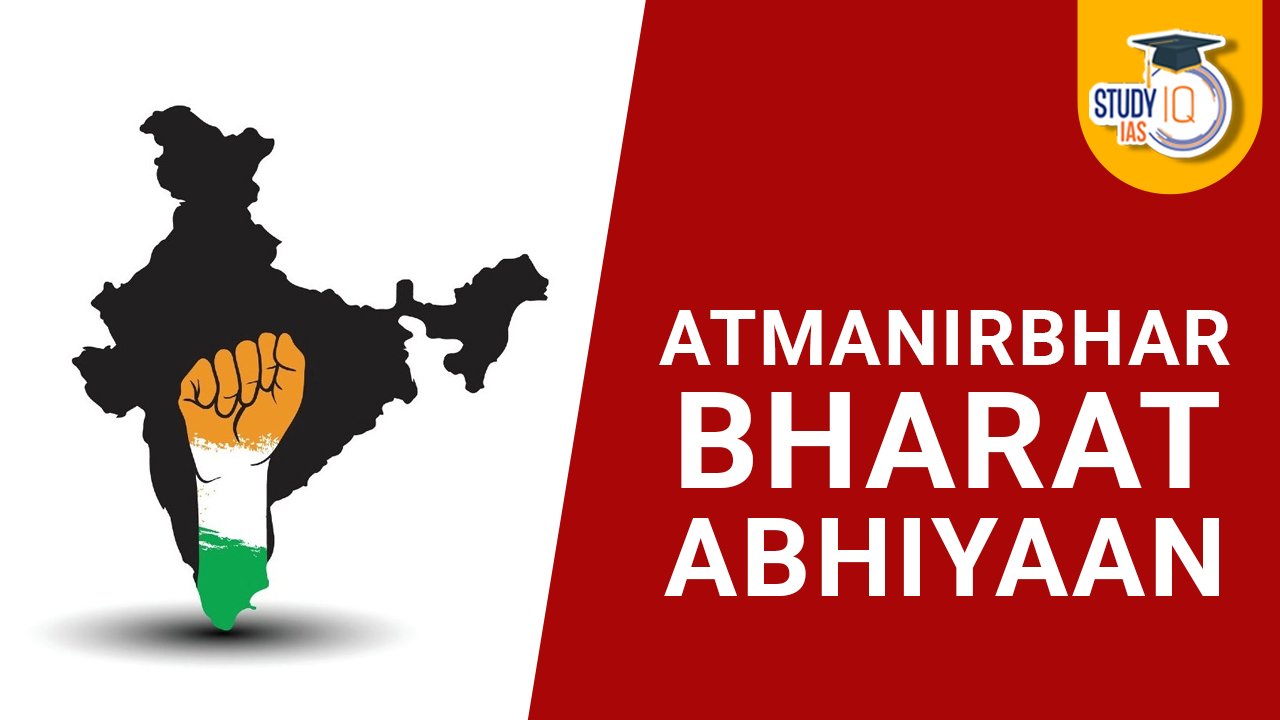Table of Contents
Atmanirbhar Bharat Abhiyaan
The Self-Reliant India campaign, also known as Atmanirbhar Bharat Abhiyaan, represents the new India’s objective. The Atmanirbhar Bharat Abhiyaan was launched by the Prime Minister in 2020, and he also announced the Special Economic and Comprehensive Package of INR 20 lakh crores, which is equivalent to 10% of India’s GDP.
Atmanirbhar Bharat Abhiyaan or self-reliant India was launched by the PM in the wake of the Covid pandemic to manage the economic disruption in the country. The goal of the Atmanirbhar Bharat programme is to use a comprehensive economic stimulus package to make the nation and its citizens self-sufficient and independent.
The COVID-19 vaccine development process highlighted the Atmanirbhar Bharat Abhiyaan and was displayed by the Department of Biotechnology in their tableau on India’s 72nd Republic Day. The Atmanirbhar Bharat Abhiyan topic is an important portion of the UPSC syllabus. Check here the Atmanirbhar Bharat scheme’s four tranches, significant pillars, the latest news, and many more.
Atmanirbhar Bharat Abhiyaan Scheme
In order to help the country recover from the economic shock brought on by the Coronavirus pandemic, the Indian Prime Minister officially announced the Atmanirbhar Bharat Abhiyaan Scheme. On May 12, 2020, the Atmanirbhar Bharat Abhiyan Scheme was introduced with the intention of utilising a crisis as an opportunity. The programme intends to reduce reliance on imports and increase the use of high-quality domestic products to make India self-sufficient.
The Atmanirbhar Bharat Abhiyaan does not advocate for a closed, solitary, or self-centred system. However, it depicts Indian culture and heritage as “Vasudhaiva Kutumbakam,” which talks about independence and the spirit. The Sanskrit word “Vasudhaiva Kutumbakam” is borrowed from the Maha Upanishad. It denotes the idea of a single global family.
The five key pillars of the Atmanirbhar Bharat Abhiyaan, which aims to create an independent India, are the economy, infrastructure, our system, demography, and demand. Nirmala Sitharaman, India’s Finance Minister, issued five distinct tranches of economic assistance packages for the development of various industries following the introduction of this programme.
Atmanirbhar Bharat Abhiyan in India
A number of initiatives are part of the Atmanirbhar Bharat Abhiyan, which was launched at the start of the pandemic era. This package combined several Reserve Bank of India regulations with some payments from the Pradhan Mantri Garib Kalyan Yojana (PMGKP). The four main areas of land, labour, legislation, and liquidity were the focus of the Indian Prime Minister’s package. By enhancing product quality and quantity domestically, the Atmanirbhar Bharat plan seeks to decrease product imports.
This mission is more about generating a helping hand for the world by strengthening the local population than it is about any exclusionary strategy. The fundamental goal of the Atmanirbhar Bharat mission is to promote domestic goods. It was completed in two stages, the first of which focused on the fields of electronics, drugs, textiles, and plastics, and the second of which examined items linked to jewellery, steel, jewels, and pharmacies. Atmanirbhar Bharat is more supportive of the Make in India movement, which promotes Indian manufacturing.
Key Features of Atmanirbhar Bharat Abhiyaan
As the United Kingdom India Business Council published a paper in 2021 titled “Road to a UK-India Free Trade Agreement: Enhancing the Partnership and Achieving Self Reliance,” the Atmanirbhar Bharat Abhiyan has recently made headlines. According to an annual study on conducting business in India that was included in this report, 77% of British businesses saw the Atmanirbhar Bharat Abhiyan as a chance to implement their business plans rather than a challenge.
However, the UK India Business Council emphasised that various reforms included in the Atmanirbhar Bharat programme may have adverse effects on the United Kingdom and many other global corporations.
Objectives of Atmanirbhar Bharat Abhiyaan
The Atmanirbhar Bharat Abhiyan’s overarching goal is to decrease reliance on the import of any foreign commodities and places more emphasis on the domestic manufacture of their substitutes in order to increase compliance and produce high-quality goods with a worldwide market share.
The Atmanirbhar Bharat Abhiyaan puts more of an emphasis on advocating for locals and highlighting locally produced goods that benefit the rest of the nation. It has already made a 20 lakh crore financial release and would continue to do so in order to support MSMEs, cottage businesses, and Middle-Class industries as well as labourers. The goal is to become a helpful hand and partner for global economic growth by lowering imports, increasing domestic production, and raising exports.
Atmanirbhar Bharat Abhiyaan Five Pillar
PM Narendra Modi announced the five pillars for building an independent India in his speech on May 12, 2020. Explore the points that have been discussed here to learn more about Abhiyaan’s five pillars.
- Economy: To create an economy capable of taking a quantum leap rather than developing and changing gradually.
- Infrastructure: To build more and more facilities within the nation so that it becomes the centre of attention and the symbol of contemporary India.
- System: To develop a technologically advanced system capable of meeting the demands and aspirations of the twenty-first century. Contrary to earlier circumstances, the current system would be completely modernized.
- Demography: The country’s current millennial population, which is aspirational enough to raise the country to a global level and transform it from a developing to a developed country, makes up the country’s lively demography. India would be given opportunities to develop and become a self-sufficient country because it is the largest democracy in the world.
- Demand: There must be sufficient supply for a demand cycle to form. In order to maximise the exploitation of the requirements of the nation, Atmanirbhar Bharat seeks to establish an appropriate cycle of supply and demand within the economy.
Schemes under Atmanirbhar Bharat Abhiyan
The Atmanirbhar Bharat Abhiyan’s main goal is to make India’s economy self-sufficient and assist the government in reaching the ambitious goal of making India a US$5 trillion economy. The key components of the Atmanirbhar Bharat stimulus package, which the Indian government unveiled in May 2020, are listed below:
- A 50 lakh rupee insurance policy for each health professional.
- Beginning in May 2020, 80 crores of the impoverished would receive 5 kilogrammes of rice or wheat each person for three months.
- Beginning in May 2020, each household receives 1 kg of pulses every three months.
- 20 billion women From May 2020, owners of Jan Dhan accounts get INR 500 per month for three months.
- Eight crore low-income families received free petrol cylinders for a period of three months.
- The MNREGA pay was raised from INR 182 to INR 202 per day. This helped 13.62 billion families.
- Farmers received a front-loaded payment of INR 2,000 under PM-KISAN. The 8.7 crore farmers benefited from this.
- The RBI enhanced the State Overdraft Duration Limits and the State Ways and Means Advance Limits by 60% each.
- The deadline for filing GST and income tax returns has been moved to June 30, 2020.
- A three-month moratorium on instalment and interest payments for all Term Loans’ Working Capital Facilities.
- Collateral-free automatic loans for businesses, including MSME, in the amount of INR 3 lakh crores.
- Infusion of INR 50,000 crore in equity through the MSME Fund of Funds.
- A lending ceiling of Rs. 25,000 crores was allowed for 25 lahks new Kisan Credit Cards.
- Between March 1 and April 30, 2020, 63 lakh loans totalling Rs. 86,600 crores were approved in the agricultural sector.
- An increase in emergency working capital of Rs 30,000 crore for farmers through NABARD.
Atmanirbhar Bharat Abhiyan Benefits
The Indian government initiated the Atmanirbhar Bharat Abhiyan programme to encourage domestic production and lessen its reliance on imports. Among Atmanirbhar Bharat Abhiyan’s benefits are:
- The campaign’s goal is to encourage domestic manufacturing so that India may become self-sufficient. This would not only increase employment opportunities but also reduce reliance on imports and strengthen the nation’s economy.
- The campaign supports neighbourhood companies financially and in other ways to promote innovation and entrepreneurship.
- The Atmanirbhar Bharat Abhiyan seeks to lessen India’s dependency on imports from abroad, particularly in vital industries like technology and defence. This will improve India’s national security.
- The campaign’s goal is to protect and promote India’s rich cultural heritage through encouraging local manufacturing and products.
Atmanirbhar Bharat Abhiyan Phases
Nirmala Sitharaman, the Union Finance Minister, unveiled the Atmanirbhar Bharat Abhiyan, or “self-reliant India scheme,” in four installments in May 2020.
Five Phases or Tranches of the Atmanirbhar Bharat Scheme are announced in order to encompass activities in various Indian economic sectors. Details of the Atmanirbhar Bharat Abhiyan package were released in the following five phases by Finance Minister Nirmala Sitharaman:
Atmanirbhar Bharat Abhiyaan Tranche 1
Atmanirbhar Bharat’s First Tranche, which primarily focuses on the Micro, Small, and Medium Enterprises sector, was announced on May 13, 2020. It includes the aforementioned projects:
| Focus Area | Measures Announced |
| MSME |
|
| Employees |
|
| Financial Institutions |
|
| Power Sector DISCOMs |
|
| Real Estate & Construction |
|
| Taxpayers |
|
| Total Financial Outlay | Rs 5,94,550 crore |
Atmanirbhar Bharat Abhiyaan Tranche 2
The Second Tranche of this scheme focuses on migrants, farmers, tiny businesses, and street vendors. It covers the following initiatives:
| Focus Area | Measures Announced |
| Food Grains Supply & One Nation, One Ration Card |
|
| Housing |
|
| Credit Facility |
|
| Employment Generation | The creation of jobs in urban, semi-urban, rural, and tribal communities will be financed by the Compensatory Afforestation Management & Planning Authority (CAMPA). |
| Agriculture |
|
| Total Financial Outlay | Rs 3,10,000 crore |
Atmanirbhar Bharat Abhiyaan Tranche 3
The Third Tranche of this scheme focuses on the agriculture sector including Governance and Administrative Reforms. It covers the following initiatives:
| Focus Area | Measures Announced |
| Agriculture Infrastructure | Construction of farm-gate and aggregation points would be funded by the Rs 1 lakh crore Agri Infrastructure Fund. |
| Herbal Cultivation | The Ganga River’s bank will see help for the development of medicinal plants from the National Medicinal Plants Board. |
| Micro Food Enterprises (MFE) | “Vocal for Local with Global Outreach” was introduced through the formalisation of FME and technical advancement. Increasing the scope of the plan from “TOP” to “TOTAL”. |
| Animal Husbandry |
|
| Governance and Administrative Reforms |
|
| Total Financial Outlay | Rs 1,50,000 crore |
Atmanirbhar Bharat Abhiyaan Tranche 4
The Fourth Tranche of this scheme focuses on structural reforms in Eight Sectors including coal mining, defence, etc. It covers the following initiatives:
| Focus Area | Measures Announced |
| Coal Sector |
|
| Mineral Sector |
|
| Defense Sector |
|
| Civil Aviation Sector |
|
| Power Sector |
|
| Space Sector |
|
| Atomic Energy Sector |
|
Atmanirbhar Bharat Abhiyaan Tranche 5
The Fifth and last Tranche of this scheme focus on Seven Sectors. It covers the following initiatives:
| Focus Area | Measures Announced |
| Health Sector |
|
| Education |
|
| MGNREGA | Allocation of more funding to help migratory workers find work. |
| Relaxation in Business Laws | Decriminalization of minor technical and procedural violations under the Companies Act; Reduction of the Insolvency and Resolution Code’s 2016 Minimum Insolvency Threshold. |
| State Government | The Centre has decided to raise state borrowing limits from 3% to 5%. |
| Total Financial Outlay (Fourth & Fifth Tranche) | Rs 48,100 crore |
Atmanirbhar Bharat Abhiyaan Facts for UPSC
Facts and figures related to Government schemes are very important for the UPSC exam. So, some of the important facts related to the Atmanirbhar Bharat Abhiyaan Scheme are given below in the following overview table:
| Atmanirbhar Bharat Abhiyaan Important Facts for Exam | |
| Full name of the Scheme | Atmanirbhar Bharat Abhiyaan Scheme |
| Launched on | 12th May 2020 |
| Announced by | Prime Minister of India Mr. Narendra Modi |
| Financial Outlay | Rs. 20 lakh crores (10% of GDP) |
| Key Pillars | 5 pillars of Atmanirbhar Bharat –
|
| Focus Areas |
|
| Phases of Atmanirbhar Bharat | There are Five Phases –
|
By expanding the availability of low-cost financing and supporting business and agriculture, the Atmanirbhar Bharat Abhiyan strategy seems to give a significant supply-side push. The MNREGA will benefit from extra financing by giving returning migrants jobs that are worthwhile. Demand-side stimulation through deficit financing is not currently being investigated.
However, there is no doubting the urgent need for demand stimulation at the moment. The need for industrial goods and services must grow, as must the purchasing power of the general populace. The need for income support for migrant workers and the underprivileged in urban areas is also urgent. Consequently, even in the face of diminishing income, a more forceful fiscal stimulus may have been tried.


 TALASH Initiative: Objective, Key Featur...
TALASH Initiative: Objective, Key Featur...
 Mukhyamantri Majhi Ladki Bahin Yojana, O...
Mukhyamantri Majhi Ladki Bahin Yojana, O...
 WHO Launched 3 by 35 Initiative targets ...
WHO Launched 3 by 35 Initiative targets ...





















